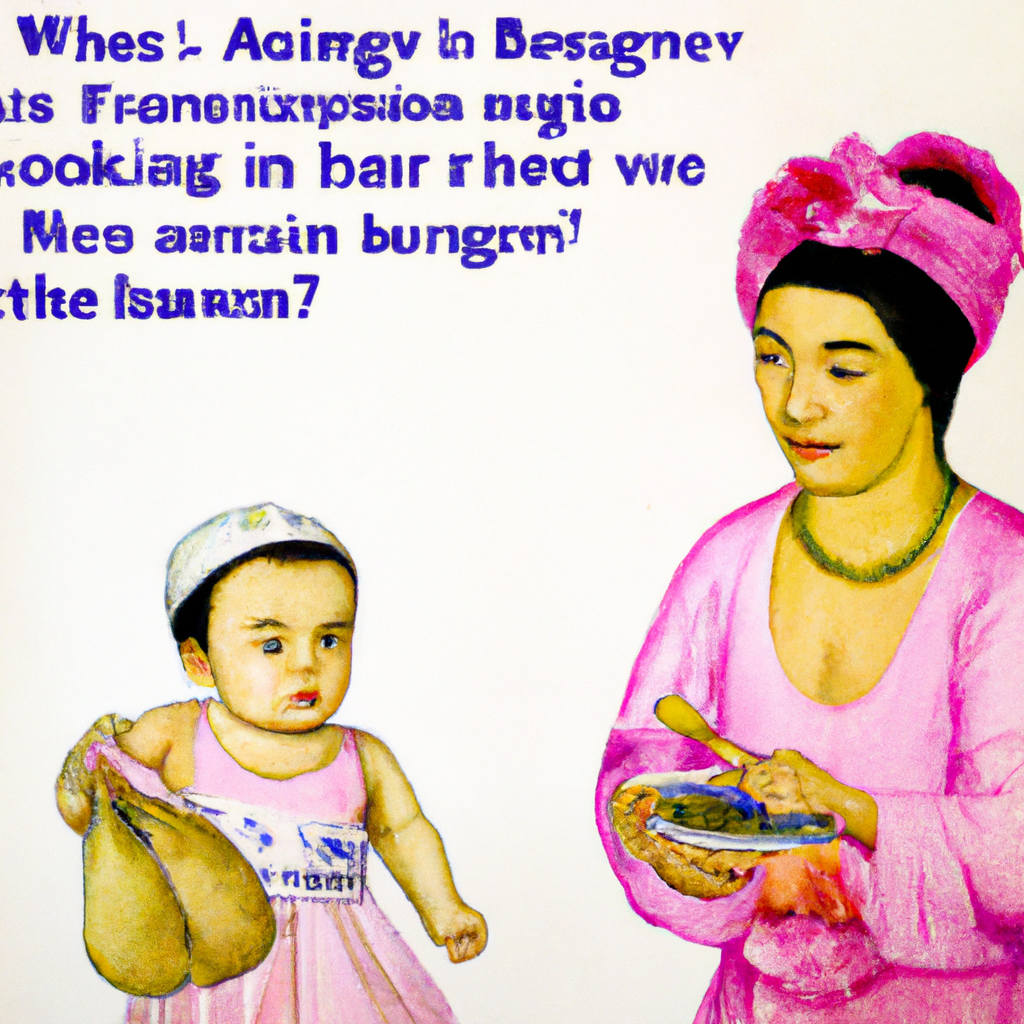Breastfeeding has been a vital part of human history, nurturing and sustaining infants since the beginning of time. For centuries, mothers have seen it as the natural and instinctive way to nourish their babies, passing down vital nutrients and providing essential bonding moments. But how did breastfeeding practices evolve throughout history? From ancient civilizations to present-day, this article will take you on a journey exploring the fascinating history of breastfeeding practices and the cultural and societal shifts that have shaped our understanding of this timeless tradition. So grab a cup of tea, sit back, and let’s embark on this enlightening exploration together.
Ancient Times
Breastfeeding in prehistoric times
Breastfeeding has been a fundamental part of human survival since prehistoric times. In the early days of human existence, there were no alternatives to breast milk, and it served as the sole source of nutrition for infants. Primitive societies revered breastfeeding as a sacred and natural act, and it played a vital role in sustaining the survival of their communities. Breastfeeding in prehistoric times was undoubtedly a practical necessity, ensuring the health and survival of infants in the harshest of circumstances.
Breastfeeding in Ancient Egypt
Ancient Egyptians held breastfeeding in high regard, as evidenced by the art and literature of the time. The pharaohs recognized the nourishing properties of breast milk and considered it essential for the growth and development of their heirs. Breastfeeding was not only seen as a biological function but also as a divine duty. The goddess Isis, who was often depicted breastfeeding her son Horus, served as a symbol of fertility and the life-giving power of breastfeeding.
Breastfeeding in Ancient Greece and Rome
Breastfeeding played a crucial role in the ancient Greek and Roman societies, with mothers breastfeeding their own children as a natural and biological practice. The ancient Greeks and Romans understood the importance of breast milk in promoting infants’ health and immunity. Breastfeeding was seen as the norm, and wet nursing was relatively uncommon during this period. Mothers were encouraged and supported in nurturing their own offspring through breastfeeding.
Breastfeeding in ancient civilizations
Breastfeeding practices varied across ancient civilizations, with factors such as culture, religion, and social norms shaping how breastfeeding was perceived and practiced. In some ancient societies, breastfeeding was a common and celebrated practice, while in others, it was seen as a duty and obligation of motherhood. It is essential to note that while breastfeeding was prevalent, wet nursing also existed in certain civilizations, providing an alternative for women unable to breastfeed their own children.
Middle Ages
Breastfeeding in Europe during the Middle Ages
During the Middle Ages in Europe, breastfeeding continued to be the primary means of providing nourishment to infants. It was seen as a natural and essential part of motherhood, firmly rooted in religious and social customs. Breastfeeding was not only a practical necessity but also represented the nurturing and maternal role of women in medieval society. Mothers were expected to breastfeed their own children, and it was considered a duty and privilege.
The influence of religion on breastfeeding practices
Religion played a significant role in shaping breastfeeding practices during the Middle Ages. Christianity, as the dominant religion, emphasized the importance of maternal breastfeeding and condemned the practice of wet nursing. Breastfeeding was viewed as a divine act of love and a means to nurture and bond with one’s child. The religious teachings and beliefs of the time reinforced the cultural norms surrounding breastfeeding and discouraged alternative feeding methods.
Wet nursing and its prevalence
Although breastfeeding by mothers was the ideal in medieval society, the practice of wet nursing existed, particularly among the upper classes. Wet nurses were women who would breastfeed infants whose mothers were unable or unwilling to do so. Wet nursing was more prevalent among the nobility, as women from higher social classes often entrusted their babies to wet nurses. This practice allowed aristocratic women to fulfill their social obligations while ensuring their babies received the nourishment they needed.


Renaissance and Early Modern Period
Breastfeeding among the nobility
During the Renaissance and Early Modern Period, breastfeeding among the nobility became more complex due to societal expectations and the rise of courtly culture. Noble women were often expected to focus their attention on social and political duties rather than breastfeeding their own children. As a result, wet nurses played a significant role in the upbringing of noble infants. This separation of mother and child had implications for the mother-infant bond, as well as for the transmission of immunities through breast milk.
The emergence of breastfeeding manuals
The Renaissance brought about a surge in the publishing of breastfeeding manuals, reflecting society’s growing interest in childcare practices. These manuals provided guidance and advice to mothers on various aspects of breastfeeding, including techniques, diet, and common issues. One notable publication was “The Holy Nurture of Nature,” written by Dutch physician Johannes Frobenius in 1628. These manuals aimed to educate and empower mothers in breastfeeding their own children.
Influence of early medical thinking on breastfeeding
Early medical thinking during the Renaissance and Early Modern Period had a significant impact on breastfeeding practices. Alarmed by high infant mortality rates, physicians and scholars became increasingly interested in understanding and promoting breastfeeding. They recognized breast milk as a superior form of nutrition and emphasized its benefits for infant health and development. This medical endorsement helped reinforce breastfeeding as the preferred method of infant feeding.
18th Century
The rise of wet nursing
The 18th century witnessed a significant rise in the practice of wet nursing, particularly among the upper and middle classes. As European society became more urbanized and industrialized, the demands of social life and motherhood often conflicted. Many women, especially those from privileged backgrounds, turned to wet nurses to feed and care for their infants, allowing them to participate more fully in professional and social activities. This shift had both positive and negative ramifications, as wet nursing provided an alternative for women who couldn’t breastfeed but also introduced challenges in maintaining the mother-infant bond.
The impact of industrialization on breastfeeding practices
The industrial revolution of the 18th century profoundly affected breastfeeding practices. Factories and urbanization led to changes in women’s roles and increased workplace demands. As women entered the workforce, breastfeeding became more challenging to sustain due to the lack of flexibility and social support. This, combined with the rising popularity of wet nursing, resulted in a decline in maternal breastfeeding. The societal shift towards bottle feeding and artificial baby foods began to take hold during this period.


19th Century
The rise of artificial feeding methods
The 19th century marked a significant shift away from breastfeeding, with the advent of artificial feeding methods gaining popularity. The Industrial Revolution led to the mass production of feeding bottles, formula, and other substitutes for breast milk. These innovations, combined with the pressures of a changing society, made it easier for mothers to opt for artificial feeding over breastfeeding. The rise of formula feeding had a significant impact on infant mortality rates, as artificial milk often lacked the necessary nutrients and antibodies found in breast milk.
The emergence of breastfeeding advocacy
Amidst the rise of artificial feeding methods, a growing awareness of the benefits of breastfeeding emerged. A group of physicians, known as the “breastfeeding advocates,” began to promote breastfeeding as the ideal method of infant feeding. These advocates highlighted the health advantages, bonding opportunities, and emotional well-being associated with breastfeeding. They called for societal support for breastfeeding mothers and pushed for improved access to education and resources to encourage breastfeeding.
The role of social class in breastfeeding practices
Social class played a crucial role in determining breastfeeding practices during the 19th century. Women from the lower socioeconomic classes often had no choice but to breastfeed due to financial constraints. On the other hand, upper-class women often relied on wet nurses or artificial feeding methods, influenced by societal expectations and the desire to maintain their social standing. This disparity in breastfeeding practices highlighted the social and economic factors that affected infant feeding choices.
Early 20th Century
The advent of formula feeding
The early 20th century saw a major shift towards formula feeding, driven by advancements in science and technology. The introduction of commercially produced infant formulas made it easier for mothers to feed their babies without breastfeeding. With formula feeding becoming more accessible and culturally accepted, breastfeeding rates declined significantly. The use of formula also brought about a perception that it was a more “modern” and convenient method of feeding compared to breastfeeding.
The influence of cultural and societal pressures on breastfeeding
Cultural and societal pressures heavily influenced breastfeeding practices in the early 20th century. The emerging ideals of convenience, independence, and modernity played a significant role in shaping attitudes towards breastfeeding. Women faced increasing pressure to conform to societal expectations, which often prioritized the use of formula or societal norms associated with modesty. The relentless marketing of baby formula by commercial companies further promoted formula feeding as an attractive alternative to breastfeeding.


Mid-20th Century
The resurgence of breastfeeding
In the mid-20th century, there was a resurgence of interest in breastfeeding as women began to question the dominant cultural norms surrounding infant feeding. The feminist movement of the 1960s and 1970s challenged traditional gender roles and brought attention to the importance of female empowerment, including the freedom to make choices about breastfeeding. This resurgence led to a renewed understanding of the health benefits of breastfeeding and a push for more supportive policies and laws to protect and encourage breastfeeding mothers.
Medical advancements and breastfeeding practices
Medical advancements in the mid-20th century also contributed to a renewed emphasis on breastfeeding. Scientific research confirmed the numerous health benefits of breast milk, including its protective properties against infections and diseases. This knowledge, coupled with advancements in lactation education and support, helped healthcare professionals provide accurate information and guidance to mothers. The medical community began to advocate for exclusive breastfeeding and actively worked towards improving breastfeeding rates.
Late 20th Century
The promotion of breastfeeding by public health organizations
In the late 20th century, public health organizations worldwide recognized the importance of breastfeeding and actively promoted its benefits. Organizations such as the World Health Organization (WHO) and UNICEF developed international guidelines advocating for exclusive breastfeeding for the first six months of an infant’s life. They worked towards creating supportive environments for breastfeeding, including implementing workplace policies, healthcare provider training, and public education campaigns. These efforts aimed to normalize breastfeeding and provide mothers with the necessary resources to breastfeed successfully.
The influence of feminism on breastfeeding practices
Feminism continued to shape breastfeeding practices in the late 20th century. The feminist movement’s emphasis on women’s rights and bodily autonomy aligned with the promotion of breastfeeding as a natural and empowering act. Breastfeeding became a symbol of female strength and independence, challenging societal expectations and questioning the influence of formula marketing. Feminist activists played a crucial role in advocating for women’s choices in infant feeding and fighting against the stigma surrounding breastfeeding in public.


21st Century
The continued debate over breastfeeding vs formula feeding
The 21st century remains a time of ongoing debate and discussion over the benefits of breastfeeding versus formula feeding. While scientific evidence overwhelmingly supports the advantages of breastfeeding, mothers continue to make personal choices based on various factors such as lifestyle, personal health, social support, and individual circumstances. The debate surrounding breastfeeding versus formula feeding highlights the need for comprehensive support systems to ensure that all mothers have access to accurate information and resources to make informed choices.
Technological advancements and breastfeeding
Technological advancements have revolutionized breastfeeding practices in the 21st century. Electric breast pumps, breastfeeding apps, online support communities, and lactation consultants have made it easier for mothers to initiate and continue breastfeeding. These advancements have helped address some of the practical challenges faced by breastfeeding mothers, such as returning to work or managing low milk supply. Technology has played a significant role in improving the breastfeeding experience and providing additional support to mothers.
Breastfeeding in public
The issue of breastfeeding in public remains a topic of contention and cultural debate in the 21st century. While many countries have laws protecting a mother’s right to breastfeed in public, societal attitudes towards public breastfeeding vary. Some societies fully embrace breastfeeding in public as a natural act, while others still hold conservative viewpoints. Advocacy groups and campaigns continue to work towards normalizing breastfeeding in public spaces and combating the stigma associated with it.
Future Trends
Predictions for the future of breastfeeding practices
As we look to the future, several trends can be anticipated in breastfeeding practices. Increased awareness of the long-term health benefits of breastfeeding is likely to lead to greater support for breastfeeding mothers. The adoption of family-friendly workplace policies and public health campaigns will help create environments conducive to breastfeeding. Additionally, advancements in lactation research and technology may lead to improved breastfeeding support systems, further enhancing the overall breastfeeding experience for mothers and infants.
The impact of societal changes on breastfeeding
Societal changes, including shifts in family structures, work-life balance, and cultural attitudes, will continue to influence breastfeeding practices. The evolving role of men in childcare, increasing gender equality, and the recognition of shared parenting responsibilities can have a positive impact on breastfeeding rates. Supportive societal structures, including paid parental leave, breastfeeding-friendly workplaces, and public facilities, will play a crucial role in encouraging and facilitating breastfeeding. Continued efforts to challenge societal norms and promote breastfeeding as the optimal method of infant feeding will be vital in improving breastfeeding rates worldwide.
In conclusion, the history of breastfeeding practices is a journey that has been shaped by various cultural, religious, economic, and sociopolitical factors. From prehistoric times to the present day, breastfeeding has played a critical role in nurturing and nourishing infants. While practices have evolved over time, the importance of breastfeeding in promoting infant health and well-being remains constant. With ongoing advocacy, support, and understanding, we can foster an environment that upholds breastfeeding as a natural and celebrated aspect of motherhood.


